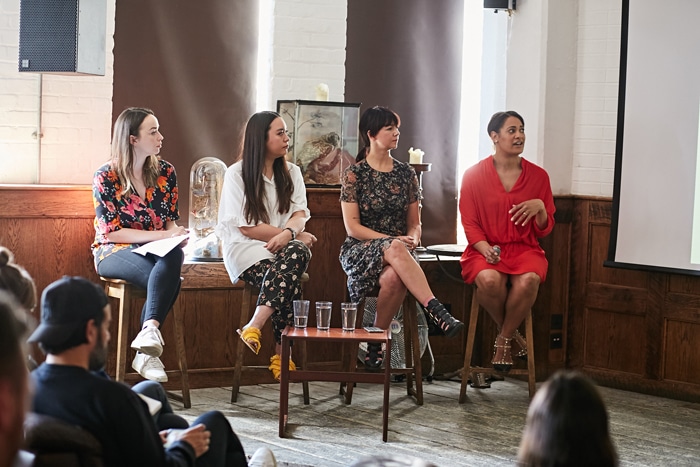
Insight
YCN Sector Briefing: Beauty
The beauty industry is one of the most fast paced industries today. From the takeover of small beauty brands now dominating the landscape to the inventive (and perhaps slightly depressing) app called ‘RYNKL’, which can track the number of wrinkles on your skin, the beauty industry really does have it all.
Recently we went to a panel discussion hosted by YCN to learn about how the beauty industry is changing and where it might go in the future. The panel consisted of: Kat Towers, Head of Culture at design studio LOVE, Karinna Nobbs, Chief Futurist at Holition and Rachel Humphrey, PR & Strategic Partnerships Director at the beauty subscription service Birchbox UK.
Here is what we learnt:
The beauty industry is shifting
Gone are the days where big brands are dominating; now over 80% of the beauty industry is made up of challenger brands, smaller companies and start-ups, and they are bringing with them a fresh and exciting outlook. From Glossier launching an eye shadow by getting anyone who’s anyone to wear it at the Oscars, to Kim Kardashian casting a mould of her body to use as her new perfume packaging, they are pushing the boundaries and shaking up the beauty industry.
Social media is as important as ever
Nowadays brands are designing products and packaging with Instagram in mind, by creating beautiful products that everyone wants to photograph and share. Social media even has the power to make brands: recently Fenty Beauty received incredible amounts of praise and publicity for its vast foundation range, featuring a large number of shades suitable for every skin tone. But it is worth noting that it works both ways, and brands can also receive a lot of negative publicity. This has resulted in many brands employing community managers, who answer customers’ questions and help with product recommendations.
Know your customer
All three speakers stressed the importance of knowing your customer. We learnt that there are two main types of customer: the beauty enthusiast and the casual beauty shopper. The beauty enthusiast will try all the latest products and trends, whereas the casual beauty shopper, who makes up 80% of beauty customers, only shops occasionally.
Karinna Nobbs outlined the importance of knowing your customer, and used her work with Charlotte Tilbury as an example; Holition have created two interactive magic mirrors that are used at their flagship store. The mirrors talk to customers and help them find suitable products. They have been very beneficial and informative, especially for customers who feel nervous and overwhelmed in beauty stores.
Pop up shops are on the up
Birchbox has recently launched its first pop up shop in London, using the same ethos as its online service and focussing on personalisations and finding the right product for each customer. As an already very successful online service, why did Birchbox feel the need to open a pop up shop? Rachel Humphrey explained: in the beauty industry in 2010, only 5% of sales were online. This means that a huge percentage of the consumers are opting to buy in-store, and so it is important for Birchbox, and other beauty brands, to experiment with pop up shops in order to reach these consumers.
From the amateur to the professional
We learnt from all three speakers about the importance of influencers and bloggers within the beauty industry. User generated content, specifically using Instagram Live, feels very real and authentic. It provides a great opportunity for influencers to interact with consumers and build an online community. As the boundaries between influencers and make up artists are blurring, the beauty industry is seeing a shift: the amateur is becoming the professional.
The beauty industry is full of contradictions
Recently there has been a big demand for a wider variety of body types to be represented in the media. So it might come as a surprise to learn that the current top model of the moment doesn’t have a real body at all, she is a CGI.
Similarly, we learnt that consumers are constantly expecting more from brands; products that are more effective, affordable and easy to use. But at the same time, they are putting increasing amounts of pressure on brands to become more eco-friendly and reduce their carbon footprint. Will they be able to do both? Rachel Humphrey commented how, at Birchbox, they are seeing an increase in consumers who do want natural beauty products; however their main focus is always going to be finding the right product for each customer. She noted that this increase in demand allows for the opportunity to create limited edition gift boxes, for example a box that contain only vegan products. It is all about trying out new things, testing the market, and learning from this in order to create an even more successful brand.
Thank you so much to the wonderful panel, and to YCN for hosting such an interesting and enjoyable morning. We left feeling inspired and in awe of the ever increasing potential of the beauty industry; considering we will take on average 25,000 selfies during our life time, we appear to be a society obsessed with image and the beauty industry looks set to continue to thrive.
Photograph by David Townhill for YCN

